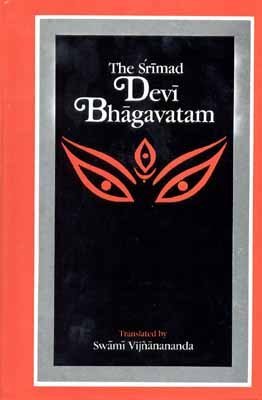The Devi Bhagavata Purana
by Swami Vijñanananda | 1921 | 545,801 words | ISBN-10: 8121505917 | ISBN-13: 9788121505918
The English translation of the Devi Bhagavata Purana. This Sanskrit work describes the Devi (Divine), the Goddess, as the foundation of the world and as identical with Brahman, the Supreme Being. The Devi Bhagavata Purana is one of the most important works in Shaktism, a branch of Hinduism focusing on the veneration of the divine feminine, along w...
Chapter 5 - On the description of the receptacle of beings and on the mountains and on the origin of rivers
1-31. Śrī Nārāyaṇa said :-- O Child Nārada! Now hear in detail about the divisions of the earth into the Dvīpas and the Varṣas as marked out by the Devas. In brief, I describe about them; no one can speak about this in details. First, the Jambu Dvīpa is one lākh Yoyanas in its dimensions. This Jambu Dvīpa is round like a lotus. There are nine Varṣas in it and excepting the Bhadrāśva and Ketumāla, each is nine thousand Yoyanas in its dimensions (i.e., in its diameter or circumference?) and there are eight very lofty mountains, in those Varṣas, forming their boundaries. Of the Varṣas, the two Varṣas that are situated in the North and South, are of the size of a bow (segmental); and the four others are elongated in their size. The centre of all these Varṣas is named Īlāvrita Varṣa and its size is rectangular. In the centre of this Īlāvarṣa is situated the golden Sumeru Mountain, the King of all the mountains, one lakh Yoyanas high. It forms the pericarp of the lotus earth. The top of this mountain is thirty Yoyanas wide. O Child! The sixteen thousand Yoyanas of this mountain is under the ground and the eighty four Yoyanas are visible outside. In the north of this Īlāvarṣa are the three mountains the Nīlagiri, the Śvetagiri and the Śriṅgavau, forming the boundaries respectively of the three Varṣas named Ramyaka, Hiraṇmaya and Kuru respectively. These run along from the east and gradually extend at their base and towards the salt ocean (Lavana Samudra).
These three mountains, that form the boundaries, are each two thousand Yoyanas wide. The length of each from the east towards north is less by one-tenth (1/10) of the above dimensions. Many rivers take their source and flow from them. On the south of Īlāvarṣa three beautiful mountain ranges, named Niṣadha, Hemakūta, and Himālayās, are situated, extending from the east. They are each one Ayuta Yoyanas high. These three mountains form the boundaries again of Kimpuruṣa and Bhārata Varṣa.
To the west of Īlāvrita is situated the mountain called Mālyavān and to the east are situated the mountains Gandhamādan, Nīla, and Niṣadha, the centres of the highest sublime grandeur and beauty. The length and breadth of these the boundary (limiting) mountains are each two thousand Yoyanas. Then the mountains Mandara, Supārśvak, and Kumuda and others are situated in the Ketumāla and Bhadrāśva Varṣas; but these all are reckoned as the Pāda Parvatas (mountains at the foot) of the Sumeru mountain. The height and breadth of each of these is one Ayuta Yoyanas. These form the pillars, as it were, of Meru on the four sides. On these mountains, the mangoe, the jack, plantain, and the fig trees and various others are situated, four hundred (400) Yoyanas wide and eleven hundred (1,100) Yoyanas high; they seem to extend to the Heavens and form, as it were, the flagstaffs on the top. The roots, bases of these trees as well as their branches are wonderfully equally thick and extend to enormous distances. On those mountain tops are situated again, the four very capacious lakes. Of these, one lake is all milk; the other lake is all honey; the third lake is all sugarcane juice and the fourth lake is all sweet water. There are, then, again the four very lovely gardens named Nandana, Caitrarath, Vaibhrājaka, and Sarvatobhadra, very lovely, enchanting and pleasing to the delicate female sex and where the Devas enjoy the wealth and prosperity and their other Yogic powers. Here the Devas live always with numerous hordes of women and have their free amorous, dealings with them, to their heart’s contents and they hear the sweet songs sung by the Gandharbas and Kinnaras, the Upa Devatās about their own glorious deeds. On the top of the Mandara mountain, there are the Heavenly mangoe trees eleven hundred Yoyanas high; the sweet delicious nectarlike mangoe fruits, very soft and each of the size as the summit of a mountain, fall to the ground; and out of their juices of a colour of the rising sun, a great river named Aruṇodā takes her origin. Here the Devas always worship the great Devī Bhagavatī named Aruṇā, the Destructrix of all sins, the Grantrix of all desires, and the Bestower of all fearlessness with various offerings and with the lovely water of this Aruṇodā river, with great devotion. O Child! In ancient days, the King of the Daityas worshipped always this Mahā
Māyā Aruṇā Devī (and obtained immense wealth and prosperity). He who worships Her becomes cured of all diseases, gets his health and other happiness by Her grace. Therefore She is named Ādyā, Māyā, Atulā, Anantā, Puṣṭī, Īśvaramālinī, the Destroyer of the wicked and the Giver of lustre and beauty and thus remembered on this capacious earth. The river Jāmbūnada has come out, as a result of Her worship, containing divine gold.
Here ends the Fifth Chapter of the Eighth Book on the description of the receptacle of beings and on the mountains and on the origin of rivers in the Mahā Purāṇam Śrī Mad Devī Bhāgavatam, of 18,000 verses, by Maharṣi Veda Vyāsa.
